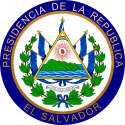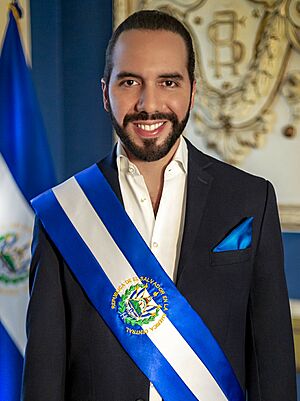President of El Salvador facts for kids
The President of the Republic of El Salvador is the main leader of El Salvador. This person is both the head of state (the country's official representative) and the head of government (the one who runs the government). The president is also the top commander of El Salvador's military.
The idea of having a president in El Salvador started with the country's first constitution in 1841. The current president is Nayib Bukele, who took office on June 1, 2019.
Since 1962, presidents serve for five years. For most of El Salvador's history, a president could not be re-elected right away. However, since 1983, the constitution has allowed a president to be re-elected once, but not immediately after their first term. More recently, in 2021, the Supreme Court said that presidents can be re-elected immediately for one more term. So, a president can serve up to two terms in total.
Every year on June 1, the president must report to the Legislative Assembly. This report covers what the president, vice president, and government ministers have done since the start of the presidential term.
Quick facts for kids President of the Republic of El Salvador |
|
|---|---|

Presidential seal
|
|
| Executive branch of the government of El Salvador | |
| Style | His Excellency |
| Residence | Casa Presidencial |
| Appointer | Elected by the citizenry |
| Term length | Five years
renewable once
|
| Constituting instrument | Constitution of El Salvador (1983) |
| Formation | 22 February 1841 |
| First holder | Juan José Guzmán |
| Succession | Line of succession |
| Deputy | Vice President of El Salvador |
| Salary | US$5,181 per month (2017) |
| Website | |
Contents
History of the Presidency
Early Leaders
In 1824, El Salvador wrote its first constitution. This created the role of "Head of State," which was like an early version of the president. When El Salvador became fully independent from the Federal Republic of Central America in 1841, its new constitution officially created the "President of El Salvador" position.
Juan Lindo was named the temporary president on February 2, 1841. Later, on September 26, 1842, Juan José Guzmán was chosen by the people as the first elected President of El Salvador. After that, the country often had many temporary leaders.
In 1858, Gerardo Barrios became president. He resigned in 1863, and Francisco Dueñas took over. The 1886 constitution changed the presidential term from two to four years. A family called the Meléndez–Quiñónez dynasty held power from 1913 until 1927, when Pío Romero Bosque became president.
Military Rule
In 1931, Vice President General Maximiliano Hernández Martínez led a takeover and removed President Arturo Araujo. This began a period where the military had a lot of control over the country. In 1939, General Martínez created a new constitution that made the presidential term six years long. During his time as president, Martínez was involved in La Matanza, a tragic event where many indigenous people were killed. Martínez was overthrown in 1944.
After Martínez, El Salvador continued to have unstable governments, often led by the military. This period of military rule lasted until 1982. In 1950, Lieutenant Colonel Óscar Osorio became president. He was known for starting social programs that helped the country.
In 1960, another takeover removed President José María Lemus. This led to a series of temporary governments. Finally, in 1962, a new constitution was created. This constitution set the presidential term at five years, starting on July 1.
On October 15, 1979, the last military takeover in El Salvador's history happened. This event started the Salvadoran Civil War, which lasted from 1979 to 1992. During the war, a group called the Revolutionary Government Junta ruled the country while fighting against the Farabundo Martí National Liberation Front (FMLN). The Junta ended in 1982, and Álvaro Magaña became president.
Modern Era
The 1983 constitution of El Salvador set the presidential term at five years, starting on June 1. The civil war made the country's politics very difficult.
President José Napoleón Duarte led the government during part of the civil war, from 1984 to 1989. In 1989, the Nationalist Republican Alliance (ARENA) won the election. Alfredo Cristiani became the first ARENA president. ARENA won several more elections, with presidents like Armando Calderón Sol, Francisco Flores, and Antonio Saca.
The Civil War officially ended in 1992. The FMLN, which was a guerrilla group, then became a legal political party.
For 20 years, El Salvador privatized many national services, meaning they were sold to private companies. In 2001, President Francisco Flores decided to use the US dollar as the official currency, which had big effects on the economy.
In 2009, Mauricio Funes won the election, ending ARENA's 20 years in power. He was the first FMLN president. Salvador Sánchez Cerén became the second FMLN president in 2014.
In 2019, Nayib Bukele, from the Grand Alliance for National Unity (GANA) party, won the election. He was the first president in a long time who was not from ARENA or FMLN. He started his term on June 1, 2019.
How Presidents Are Chosen
Who Can Be President?
To become president, a candidate must be at least 30 years old. They must be a Salvadoran citizen by birth, or have a parent who is a Salvadoran citizen. Candidates also need to be part of a political party that is registered with the Supreme Electoral Court.
Some people are not allowed to run for president. This includes the president of the Legislative Assembly, the president of the Supreme Court, cabinet ministers, and military personnel who have not been retired for at least three years. Also, close relatives of the current president cannot run.
How Elections Work
In the past, presidential elections in El Salvador were often unfair, and there was a lot of political violence.
Since the 1983 constitution, a presidential candidate must win more than half of all votes (50% plus 1) to become president. If no one gets this many votes in the first round, the two candidates with the most votes have a second election within one month.
President's Role and Powers
What the President Does
The president is part of the executive branch of the Salvadoran government, along with the vice president and the cabinet. The president chooses the cabinet ministers, vice ministers, and the governors for El Salvador's 14 departments (like states or provinces). The president is also the top leader of the military and handles El Salvador's relationships with other countries.
The president can suggest new laws to the Legislative Assembly. They can also reject laws passed by the Assembly, but the Assembly can overrule this rejection with a two-thirds vote. The president can ask the Supreme Court to decide if a law is constitutional. If the court says it is, the president must sign it into law.
Checks and Balances
The Legislative Assembly has ways to check the president's power. The president needs the Assembly's approval to leave El Salvador. The president must also report to the Assembly when asked, except for military secrets. At the start of each year, the president must tell the Assembly about the government's activities from the previous year. The Legislative Assembly can also remove the president from office with a two-thirds vote. The president cannot approve international agreements without the Assembly's permission.
The length of presidential terms has changed over time. It has been two, three, four, and six years. Since 1962, the term has been five years long.
Re-election Rules
For most of El Salvador's history, presidents were not allowed to be re-elected immediately, or sometimes not at all. The 1841 constitution allowed re-election only after a president had been out of office for at least one full term. The 1864 constitution allowed immediate re-election, but this rule changed back and forth. From 1872 until 1983, re-election was completely forbidden.
The 1983 constitution said that a president could not be re-elected if they had served in the six months before the new term began. It also said that a president could not serve three or more terms. The constitution even states that the military should step in if a president tries to get re-elected illegally.
In May 2021, the Legislative Assembly changed the five judges of the Supreme Court's Constitutional Chamber. In September 2021, the new judges decided that the constitution actually allows a president to be re-elected immediately. They said the old rule meant that someone who was president *before* the current term couldn't run, not the current president themselves. Many lawyers and politicians disagreed with this new interpretation.
Only six presidents in El Salvador's history have been successfully re-elected: Doroteo Vasconcelos, Francisco Dueñas, Santiago González, Rafael Zaldívar, Maximiliano Hernández Martínez, and Nayib Bukele.
Who Takes Over?
If the president cannot serve, the vice president is next in line to take over. If the vice president also cannot serve, the Legislative Assembly can name up to two "designates" who would then take over.
Latest Election Summary
In the 2024 presidential election, Nayib Bukele won with a large number of votes, securing his re-election. He ran with the Nuevas Ideas party. The other main candidates were Manuel Flores from the Farabundo Martí National Liberation Front and Joel Sánchez from the Nationalist Republican Alliance.
See also
 In Spanish: Presidente de El Salvador para niños
In Spanish: Presidente de El Salvador para niños
- Colonial Intendant of San Salvador


